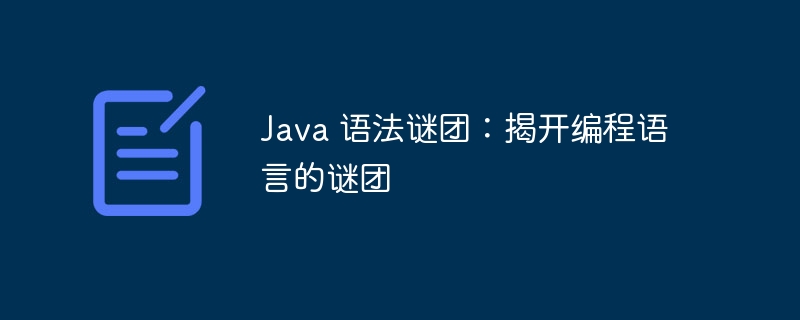Home >Java >javaTutorial >Java Syntax Mysteries: Uncovering the Mysteries of the Programming Language
Java Syntax Mysteries: Uncovering the Mysteries of the Programming Language
- WBOYWBOYWBOYWBOYWBOYWBOYWBOYWBOYWBOYWBOYWBOYWBOYWBforward
- 2024-04-03 13:16:25551browse

php Editor Apple will unveil the mystery of Java syntax for everyone today and take you to explore the mysteries of programming languages in depth. As a programming language widely used in enterprise-level development, Java's grammatical structure and features have always attracted much attention. This article will gradually analyze the core concepts of Java, such as classes, objects, inheritance, polymorphism, etc., to help readers better understand and use the Java language. Whether you are a beginner or an experienced developer, I believe this article can bring you some inspiration and help. Let us uncover the mysteries of the Java language together!
Mystery 2: The mystery of curly braces Curly braces in Java are used to define blocks of code. In structures such as constructors, functions, and loops, curly braces are used to wrap blocks of code to indicate that the code within the block will be executed under specific conditions. Note that an empty curly brace block {} also has meaning, indicating an empty block of code that does nothing.
Mystery 3: Operator precedence There is a concept of operator precedence in Java, which means that some operators have higher precedence than other operators. For example, the multiplication sign (*) has higher precedence than the plus sign ( ). By following operator precedence rules, you can avoid unexpected results due to the order in which operators are executed.
Mystery 4: The Trap of Type Conversion Type conversion in Java includes two types: automatic type conversion (implicit conversion) and forced type conversion (explicit conversion). Implicit conversion occurs automatically when the data types are compatible, while explicit conversion requires the developer to explicitly specify the data type to be converted. Note that casting may result in data loss or type errors.
Mystery 5: Confusion about method overloadingMethod overloading allows multiple methods with the same name but different parameter lists to exist in a class. Through method overloading, the same operation can be used in different scenarios to improve code reusability. However, method overloading can also cause confusion because the compiler needs to determine the specific method to call based on the argument list.
Mystery 6: The maze of exception handlingException handling is a mechanism for handling errors while a program is running. Exception handling in Java uses try-catch-finally block to catch and handle exceptions. The try block contains code that may throw an exception, the catch block is used to catch specific types of exceptions, and the finally block always executes regardless of whether an exception occurs.
Mystery 7: The Maze of ModifiersModifiers are keywords used to change the behavior of Java elements (classes, methods, variables, etc.). For example, the public modifier means that the element can be accessed by any class, and the private modifier means that the element can only be accessed within the class in which it is defined. Understanding and correctly using modifiers is critical to controlling access and encapsulation of your code.
Mystery 8: The depth of the arrayJava Array is an object that stores elements of the same data type. Arrays can be defined in a multidimensional manner, which means that one array can contain another array. Multidimensional arrays can be used to store complex data structures, but at the same time, be aware of the potential complexity and difficulty of traversal.
Mystery 9: The inherited chainJava supports single inheritance, which means a child class can inherit from only one parent class. Through inheritance, subclasses can inherit the properties and methods of the parent class and extend or override them. While inheritance provides the benefits of code reuse and polymorphism, it can also lead to code complexity and maintenance difficulties.
Mystery 10: The end of finalThe final keyword is very useful in Java. It can be used to modify classes, methods, or variables to indicate that they cannot be overridden, overwritten, or reassigned. The final keyword ensures the immutability of data and prevents accidental modification, thereby improving the security of the code.
The above is the detailed content of Java Syntax Mysteries: Uncovering the Mysteries of the Programming Language. For more information, please follow other related articles on the PHP Chinese website!
Related articles
See more- What is backend development? The role of back-end development and the technologies that need to be learned
- Is python suitable for back-end development?
- Take a look at MySQL's amazing implicit conversions
- How to convert string to array in javascript
- Implicit conversion of PHP types: understanding and application

